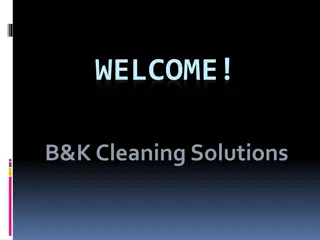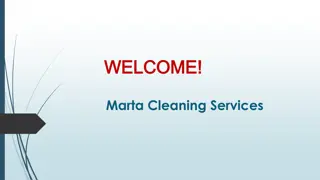Effective Cleaning and Sanitizing Procedures for Food Service Operations
This presentation covers essential topics such as selecting the correct cleaners and sanitizers, factors affecting their efficiency, cleaning food-contact surfaces, machine-dishwashing procedures, storage requirements for chemicals, developing a cleaning program, and key terms related to cleaning and sanitizing processes in food service establishments.
Download Presentation

Please find below an Image/Link to download the presentation.
The content on the website is provided AS IS for your information and personal use only. It may not be sold, licensed, or shared on other websites without obtaining consent from the author. Download presentation by click this link. If you encounter any issues during the download, it is possible that the publisher has removed the file from their server.
E N D
Presentation Transcript
Chapter Number 12 Cleaning and Sanitizing Class Name Instructor Name Date, Semester Book Title Book Author 1
Learning Objectives After this presentation, you should be able to complete the following Learning Outcomes 12.0 Correct cleaners for specific tasks 12.1 Approved sanitizers including chlorine, iodine, and quats 12.2 Factors affecting the efficiency of sanitizers 12.3 How to clean and sanitize food-contact surfaces 12.4 12.5 Required frequency for cleaning and sanitizing food-contact surfaces 2
Learning Objectives After this presentation, you should be able to complete the following Learning Outcomes 12.0 Correct machine-dishwashing procedures 12.6 How to clean and sanitize items in a three- compartment sink 12.7 How to clean nonfood-contact surfaces 12.8 Storage and disposal requirements for chemicals 12.9 How to store clean and sanitized tableware and equipment 12.10 3
Learning Objectives After this presentation, you should be able to complete the following Learning Outcomes 12.0 How to clean the premises 12.11 How to develop a cleaning program 12.12 4
12.0 KEY TERMS Cleaning: Process of removing food and other types of dirt from a surface, such as a countertop or plate. Sanitizing: Process of reducing the number of microorganisms on a clean surface to safe levels. Detergents: Cleaners designed to penetrate and soften dirt to help remove it from a surface.
12.0 KEY TERMS Concentration: The amount of sanitizer to water measured in parts per million (ppm). The concentration of sanitizer affects the effectiveness of the sanitizer solution. Degreasers: Alkaline detergents, often called degreasers, that contain a grease-dissolving agent. Water hardness: The amount of minerals in water. Water hardness affects how well a sanitizer works.
12.0 KEY TERMS Delimers: Used on mineral deposits and other soils that alkaline cleaners cannot remove, such as scale, rust, and tarnish. Material Safety Data Sheet (MSDS): Sheets supplied by the chemical manufacturer listing the chemical and its common names, its potential physical and health hazards, information about using and handling it safely, and other important information. OSHA requires employers to store these sheets so they are accessible to staff. Abrasive cleaners: Cleaners containing a scouring agent used to scrub off hard-to-remove dirt. They may scratch some surfaces.
12.1 Correct cleaners for specific tasks DETERGENTS General-purpose detergents are mildly alkaline cleaners that remove fresh dirt from floors, walls, ceilings, prep surfaces, and most equipment and utensils. Heavy-duty detergents are highly alkaline cleaners that removewax, aged or dried dirt, and baked-on grease.
12.1 Correct cleaners for specific tasks Detergents General-purpose detergents are mildly alkaline cleaners that remove fresh dirt from floors, walls, ceilings, prep surfaces, and most equipment and utensils. Heavy-duty detergents are highly alkaline cleaners that remove wax, aged or dried dirt, and baked-on grease. Degreasers Degreasers are detergents that contain a grease- dissolving agent. These cleaners work well in areas where grease has been burned on.
12.1 Correct cleaners for specific tasks Delimers Delimers are used on mineral deposits and other dirt that other cleanerscannot remove. They are often used to remove scale in dishwashing machines and on steam tables. Follow the instructions carefully and use delimers with caution. Abrasive Cleaners Abrasive cleaners contain a scouring agent that helps scrub hard- to-remove dirt. These cleaners are often used to remove baked-on food in pots and pans. Use abrasives with caution because they can scratch surfaces.
Approved sanitizers including chlorine, iodine, and quats 12.2 SANITIZING Sanitizing reduces pathogens on a surface to safe levels. Food-contact surfaces must be sanitized after they have been cleaned and rinsed. This can be done by using heat or chemicals. Heat Sanitizing Items must be soaked in hot water for at least 30 seconds. The water must be at least 171 F (77 C). You may need to install a heating device to maintain this temperature. You may also use a high-temperature dishwasher.
Approved sanitizers including chlorine, iodine, and quats 12.2 CHEMICAL SANITIZING Three common types of chemical sanitizers are: o chlorine o iodine o quaternary ammonium compounds, or quats Chemical sanitizers are regulated by state and federal environmental protection agencies (EPAs). Tableware, utensils, and equipment can be sanitized by: o soaking them in a chemical sanitizing solution o rinsing, swabbing, or spraying them with sanitizing solution o using detergent-sanitizer blends to clean then sanitize
Factors affecting the efficiency of sanitizers 12.3 SANITIZER EFFECTIVENESS Several factors influence the effectiveness of chemical sanitizers. The most critical include: o concentration o water temperature o contact time o water hardness o pH
Factors affecting the efficiency of sanitizers 12.3 Concentration Sanitizer solution is a mix of chemical sanitizer and water. The concentration of this mix the amount of sanitizer to water is critical. Too little sanitizer may make the solution weak and useless. Too much sanitizer may make the solution too strong and unsafe. o It can also leave a bad taste on items or corrode metal. Concentration is measured in parts per million (ppm). To check the concentration of a sanitizer solution, use a test kit made for the sanitizer being used. Hard water, food bits, and leftover detergent can reduce the solution s effectiveness. Change the solution when it looks dirty or its concentration is too low. Check the concentration often.
Factors affecting the efficiency of sanitizers 12.3 Temperature The water in sanitizing solution must be the correct temperature. Follow manufacturers recommendations. Contact time For a sanitizer solution to kill pathogens, it must make contact with the object being sanitized for a specific amount of time. Different requirements must be followed for each type of sanitizer. Follow the manufacturers recommendations.
Factors affecting the efficiency of sanitizers 12.3 Water hardness Water hardness is the amount of minerals in your water. Find out what your water hardness is from your municipality. Work with your supplier to identify the correct amount of sanitizerto use for your water. pH Find out what the pH of your water is from your municipality. Work with your supplier to find out the correct amount of sanitizer to use for your water.
How to clean and sanitize food-contact surfaces HOW AND WHEN TO CLEAN AND SANITIZE 12.4 All surfaces must be cleaned and rinsed. This includes walls, storage shelves, and garbage containers. However, any surface that touches food, such as knives, stockpots, cutting boards, or prep tables, must be cleaned and sanitized.
How to clean and sanitize food-contact surfaces 12.4 To clean and sanitize a surface, follow these steps:
Required frequency for cleaning and sanitizing food-contact surfaces 12.5 WHEN TO CLEAN AND SANITIZE All food-contact surfaces need to be cleaned and sanitized at these times: After they are used Before food handlers start working with a different type of food Any time food handlers are interrupted during a task and the items being used may have been contaminated After four hours if items are in constant use
Correct machine-dishwashing procedures 12.6 DISHWASHING There are two methods used by operations to wash dishes: Machine dishwashing Manual dishwashing
Correct machine-dishwashing procedures 12.6 MACHINE DISHWASHING Tableware and utensils are often cleaned and sanitized in a dishwashing machine. The effectiveness of your dishwashing program will depend on the following factors: Well-planned layout in the dishwashing area, including a scraping and soaking area and enough space for both dirty and clean items Sufficient water supply, especially hot water Separate area for cleaning pots and pans Devices that indicate water pressure and temperature of the wash and rinse cycles Protected storage areas for clean tableware and utensils Staff trained to operate and maintain the equipment and use the correct chemicals
Correct machine-dishwashing procedures 12.6 HIGH-TEMPERATURE MACHINES High-temperature machines use hot water to clean and sanitize. If the water is not hot enough, items will not be sanitized. If the water is too hot, it can bake food onto the items. The dishwasher must have a built-in thermometer which checks water temperature at the manifold.
Correct machine-dishwashing procedures 12.6 CHEMICAL-SANITIZING MACHINES Chemical-sanitizing machines can clean and sanitize at much lowertemperatures. Different sanitizers require different temperatures, so follow the manufacturer s dishwashing guidelines. Items washed and rinsed at these lower temperatures may take longer to air-dry.
Correct machine-dishwashing procedures 12.6 DISHWASHING MACHINE OPERATION Operate your dishwasher according to the manufacturer s recommendations, and keep it in good repair. However, no matter what type of machine you use, you should follow these guidelines. Cleanliness Clean the machine as often as needed, checking it at least once a day. Clear spray nozzles of food and foreign objects. Remove mineral deposits when needed. Fill tanks with clean water, and make sure detergent and sanitizer dispensers are filled. Preparation Scrape, rinse, or soak items before washing. Presoak itemswith dried-on food.
Correct machine-dishwashing procedures 12.6 DISHWASHING MACHINE OPERATION Loading Use the correct dish racks. Load them so the water spray will reach all surfaces, as shown in the photo at left. Never overload dish racks. Air-drying Air-dry all items. Never use a towel to dry items. You could re-contaminate them. Monitoring Check water temperature, pressure, and sanitizing levels. Take appropriate corrective action if necessary. Use heat tape or test strips to monitor the temperature of the sanitizing rinse. You can also use a maximum registering thermometer to do it.
How to clean and sanitize items in a three-compartment sink 12.7 MANUAL DISHWASHING Operations often use a three-compartment sink to clean and sanitize large Items. Follow these procedures: Clean and sanitize each sink and drain board. Fill the first sink with detergent and water. The water temperature must be at least 110 F (43 C). Follow the manufacturer s recommendations. Fill the second sink with clean water. This is not necessary if items will be spray-rinsed instead of being dipped. Fill the third sink with water and sanitizer to the correct concentration. Hot water can be used as an alternative. Provide a clock with a second hand. This will let food handlers time how long items have been in the sanitizer.
How to clean and sanitize items in a three-compartment sink 12.7
How to clean and sanitize items in a three-compartment sink 12.7
12.8 How to clean nonfood-contact surfaces NONFOOD-CONTACT SURFACES Nonfood-contact surfaces must be cleaned regularly. Examples include: Floors Ceilings Equipment exteriors Restrooms Walls Regular cleaning prevents dust, dirt, and food residue from building up.
Storage and disposal requirements for chemicals 12.9 USING FOODSERVICE CHEMICALS Many of the chemicals used in the operation can be hazardous, especially if they are used the wrong way. To reduce your risk, you should only use chemicals that are approved for use in a foodservice operation. You should also follow these guidelines: Storage and labeling Store chemicals in their original containers away from food and prep areas. Separate by spacing or partitioning. If chemicals are transferred to a new container, the label on that container must list the common name of the chemical. Disposal When throwing out chemicals, follow the instructions on the label and any requirements from your local regulatory authority.
Storage and disposal requirements for chemicals 12.9 MATERIAL SAFETY DATA SHEETS The Occupational Safety and Health Administration (OSHA) has requirements for using chemicals. OSHA requires chemical manufacturers and suppliers to provide a Material Safety Data Sheet (MSDS) for each hazardous chemical they sell.
Storage and disposal requirements for chemicals 12.9 MATERIAL SAFETY DATA SHEETS An MSDS contains the following information about the chemical: Safe use and handling Physical, health, fire, and reactivity hazards Precautions Appropriate personal protective equipment (PPE) to wear when using the chemical First-aid information and steps to take in an emergency Manufacturer s name, address, and phone number Preparation date of MSDS Hazardous ingredients and identity information
How to store clean and sanitized tableware and equipment 12.10 STORING TABLEWARE AND EQUIPMENT Once utensils, tableware, and equipment have been cleaned and sanitized, they must be stored in a way that will protect them from contamination. Follow these guidelines: Storage Store tableware and utensils at least six inches (15 centimeters) off the floor. Protect them from dirt and moisture. Storage surfaces Clean and sanitize drawers and shelves before storing clean items. Glasses and flatware Store glasses and cups upside down on a clean and sanitized shelf or rack. Store flatware and utensils with handles up so staff can then pick them up without touching food-contact surfaces. Trays and carts Clean and sanitize trays and carts used to carry clean tableware and utensils. Check them daily, and clean as often as needed. Stationary equipment Keep the food-contact surfaces of stationary equipment covered until ready for use.
How to store clean and sanitized tableware and equipment 12.11 CLEANING THE PREMISES Keeping your operation clean means using the correct tools, supplies, and storage to prevent contamination. Many of the chemicals you will use are hazardous, so you also have to know how to handle them to prevent injury. For all of your cleaning efforts to come together, you need a master cleaning schedule. Making this schedule work also means training and monitoring your staff to be sure they can follow it.
12.12 How to develop a cleaning program DEVELOPING A CLEANING PROGRAM A clean and sanitary operation is a foundation for a successful food safety management system. You can keep your operation in this condition with an effective cleaning program. To develop your program, first identify what the operation needs. Then create a master cleaning schedule. Train staff to clean equipment and surfaces correctly and monitor the program to ensure that it is effective.
12.12 How to develop a cleaning program IDENTIFYING CLEANING NEEDS Identify cleaning needs using the following guidelines: Review the facility to identify all surfaces, tools, and equipment that need cleaning. Look at how cleaning is currently done. Get input from staff. Ask them how and why they clean a certain way. Find out which procedures can be improved. Estimate the time and skills needed for each task. Some jobs may be done more efficiently by two or more people. Others might require an outside contractor. Determine cleaning frequency as well.
12.12 How to develop a cleaning program CREATING A MASTER CLEANING SCHEDULE Use the information you gather while identifying your cleaning needs to develop a master cleaning schedule. The schedule should include the following: What should be cleaned Who should clean it When it should be























